JUMP TO TOPIC
Digit|Definition & Meaning
Definition
In mathematics, digits are single numbers that are used to represent values. In math, the numbers 0 to 9 are used in various combinations and repetitions to represent all of the values. A digit is a symbol that can represent any of these ten numbers 0 to 9. 24 is an example of a two-digit (2-D) number. It is made up of the numbers 2 and 4.
Digit
The digits in the binary number system are the elements of the set 0 and 1. Computers use this system because the low and high logic states can be represented by two digits.
In computer jargon, the term “binary digit” is abbreviated to “bit”. The octal and hexadecimal numbering systems are also used in computing. The digits in the octal number system are the set’s elements 0, 1, 2, 3, 4, 5, 6, 7. The elements in the set 0, 1, 2, 3, 4, 5, 6, 7, 8, 9 A, B, C, D, E, and F make up the digits in the hexadecimal system.
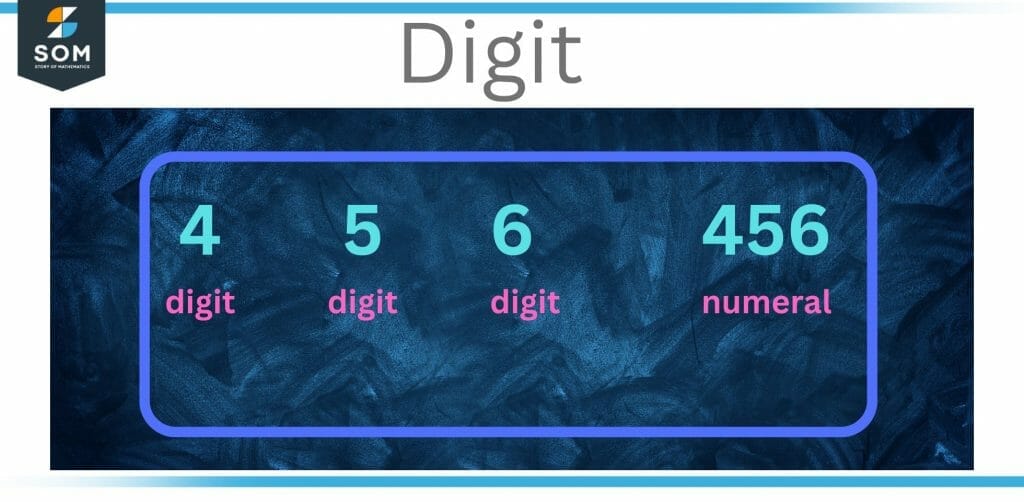
Figure 1 – Separating digits in numeral.
The term “digit” is frequently used to denote a number in a specific position within a larger number, a number that uses radix points to express a fraction.
In the decimal number 2609. For example, the number 2 represents the thousands digit, the number 6 represents the hundreds digit, the number 0 represents the tens digit, the number 9 represents the ones digit, and in numeral 37 the number 3 represents the tenths digit, the hundredth digit is represented by the number 7.
The term digit refers to a human or animal’s finger or toe in biology and anatomy. Any tiny, practical appendage in a robotic end effector may be referred to by this term.
History of Digits
When the number system was unknown thousands of years ago, people used stone tokens or Roman abacuses. The need for larger denominations was felt as time passed and trade across regions and countries advanced. As a result, number systems as we know them today were developed.
As nations advanced, so did the need to deal with larger populations. The size of a microorganism, the distance between the Earth and the Moon, and the speed of light; these enthralling facts instilled in us the desire to expand our number systems. As a result, the concept of numbers and digits was introduced.
Counting small numbers is simple. We can count the petals of a flower and the fingers on our hands without the use of a calculator or a pen and paper. In such cases, we deal with single-digit numbers. The smallest single-digit counting number is one, and the greatest is nine.
Consider the students in your class. Can you easily count them? A small class of forty to eighty students might get a yes. Similarly, for counting the number of buildings in a neighborhood, the number of general stores in a neighborhood, and so on. We use numbers up to two digits to keep track of such measures.
Numbers With Two Digits
We get the smallest two-digit number by adding one unit to the greatest one-digit number.
1 + 9 = 10
The smallest two-digit number is ten, and the greatest is ninety-nine.
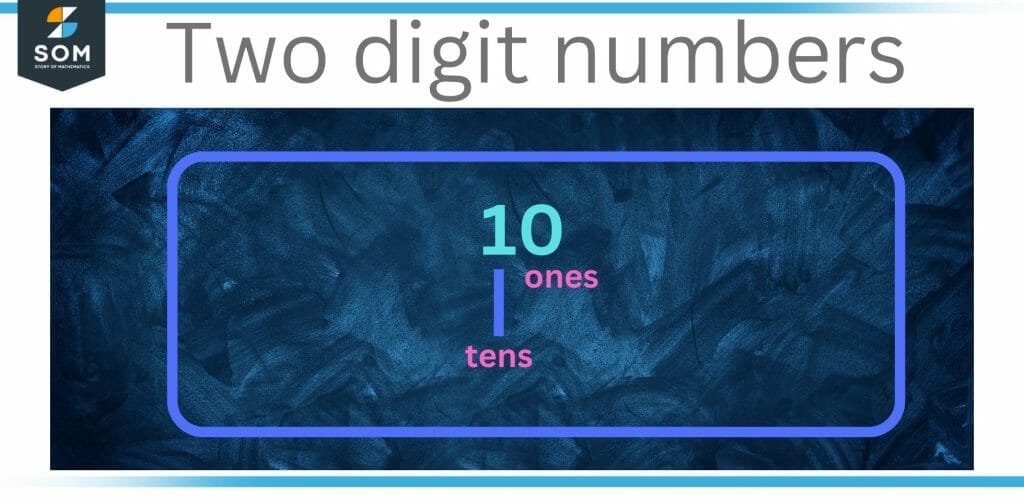
Figure 2 – Two digit numbers.
Consider an auditorium with hundreds of people. We can’t possibly count this many people with our fingertips. We use numbers up to three digits to deal with such measures.
Numbers With Three Digits
We get the smallest three-digit number by adding one unit to the greatest two-digit number.
1 + 99 = 100
100 is the smallest three-digit number, and the greatest three-digit number is 999.
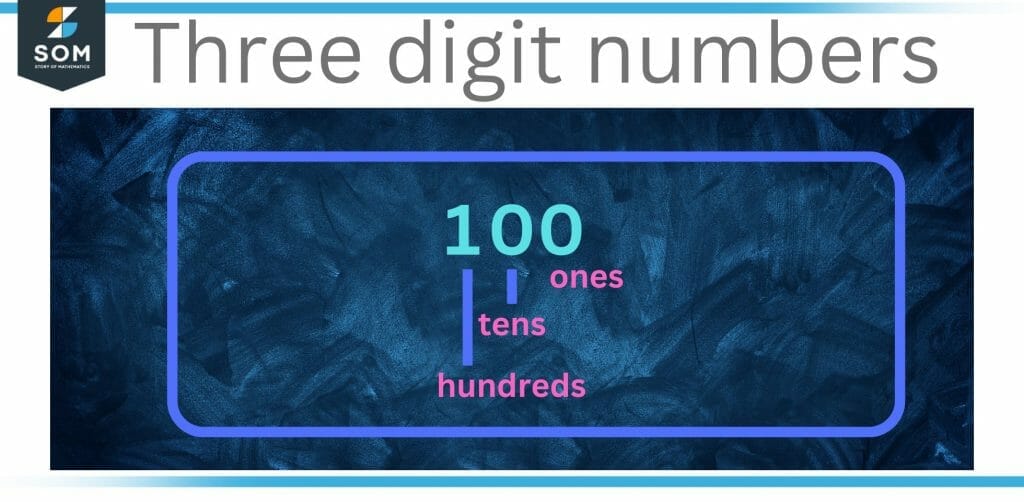
Figure 3 – Three digits numbers.
Consider the crowd in a sports pavilion, which could number in the thousands. For example, to deal with the cost of a cupboard or a bicycle, we use digits up to four digits.
Numbers With Four Digits
We get the smallest four-digit number by adding one unit to the greatest three-digit number.
1 + 999 = 1000
1000 is the smallest four-digit number, and 9999 is the largest.
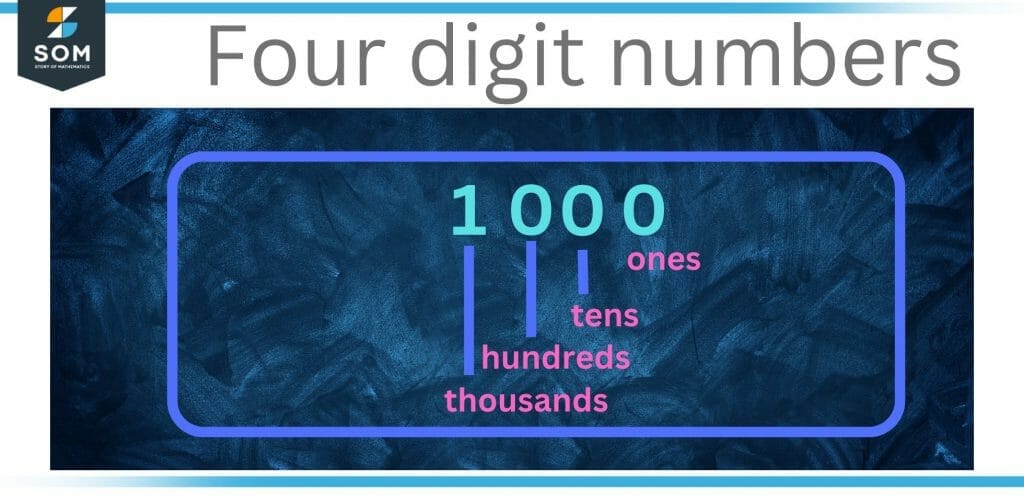
Figure 4 – Four digit numbers.
When dealing with numbers as large as a state’s population or the cost of a motorcycle, we must deal with five-digit figures.
Numbers With Five Digits
We get the smallest five-digit number by adding one unit to the greatest four-digit number.
1 + 9999 = 10000
The smallest five-digit number is 10000, while the largest is 99999.
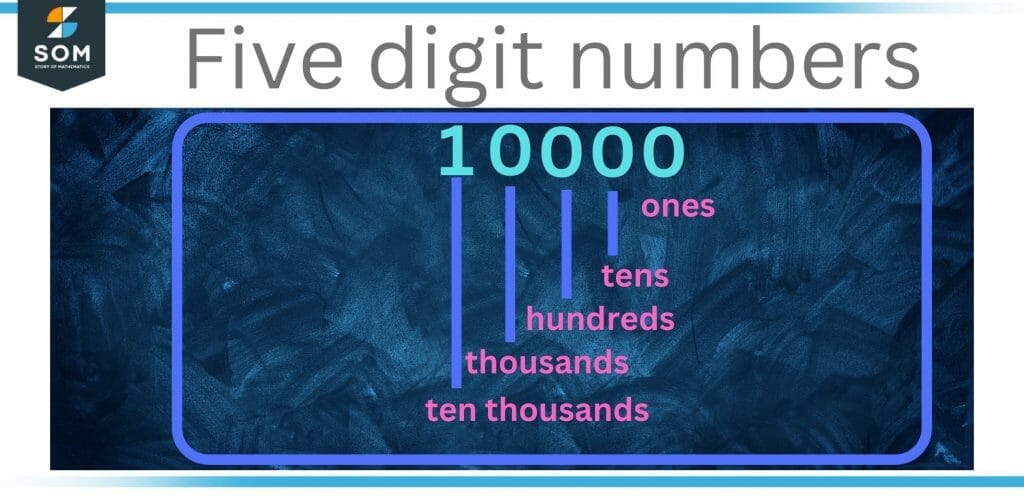
Figure 5 – Five digit numbers.
Place Value
In mathematics, each digit in a number has a place value. Place value is the value that a digit in a number denotes based on where it appears in the number.
For instance, the place value of 4 in 5465 is 400 hundreds. The place value of 4 in 4652, on the other hand, is 4 thousands or 4000. We can see here that, even though the 4 is the same in both numbers, its place value changes as its position changes.
Face Value
Face value and place value are not synonymous. The face value of a digit is its value, whereas the place value of a digit is its position in the number. Simply put, the face value represents the actual value, whereas the place value represents the value based on its position.
As a result, the digit’s face value remains constant regardless of its position in the number, whereas its place value changes as its position changes.
Taking the face value of 4 as an example in both 264 and 545 is 4. Whereas 4 has a place value of 400 in 264 and 40 in 545.
Examples of Digits in Problems
Example 1
In 6587, how many digits are there?
Solution
The number of digits in 6587 is 4, which are 6, 5, 8, and 7.
Example 2
Find the greatest three-digit number using the digits 9, 5, and 9.
Solution
The greatest three-digit number that can be formed using these is 995.
Example 3
In the number 65,847, what is the place value of the digit 5?
Solution
The place value of 5 in 65,847 is 5000 or five thousand.
Example 4
What are the smallest and greatest four digits in 1,0,0,0?
Solution
1000 is the smallest four-digit number.
9999 is the largest four-digit number.
All images/mathematical drawings were created with GeoGebra.
